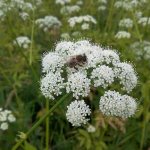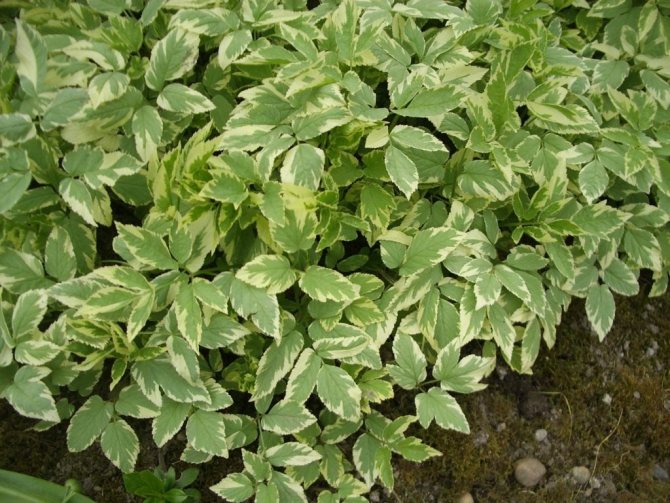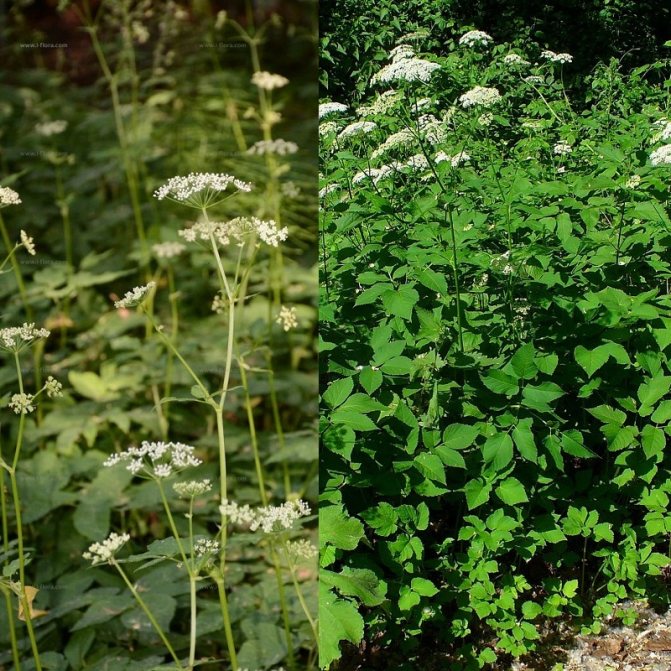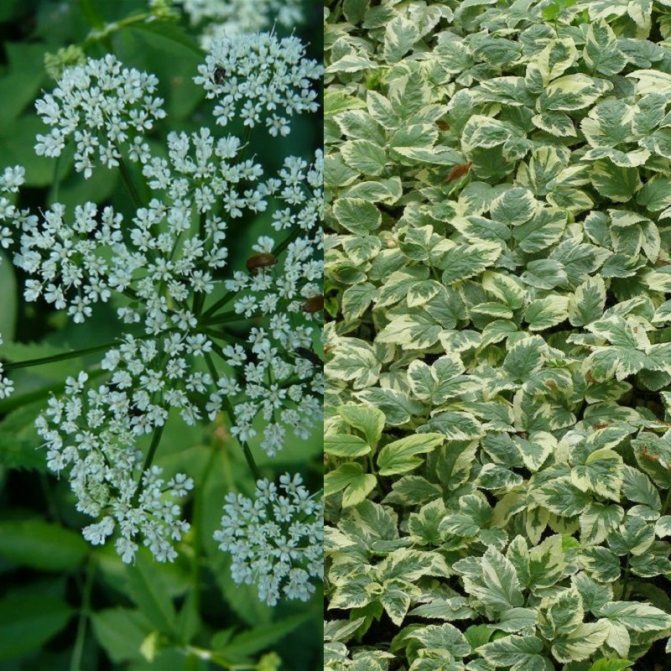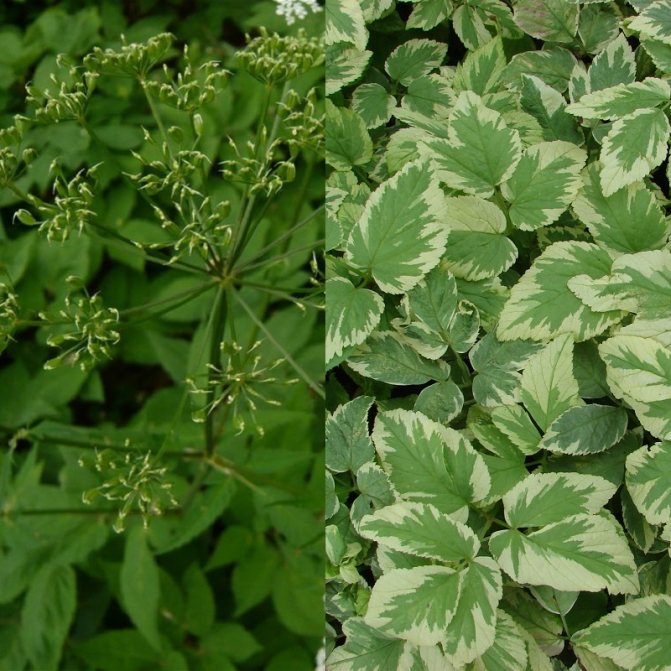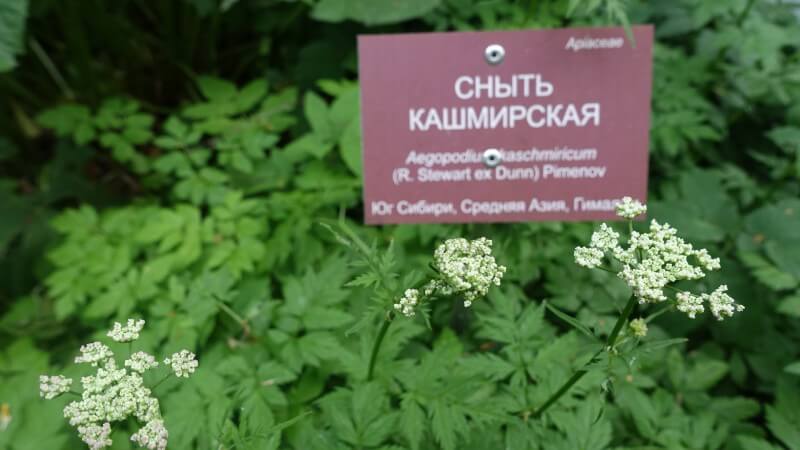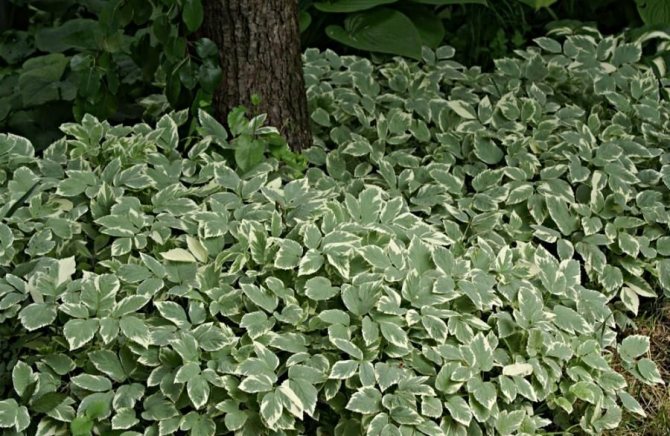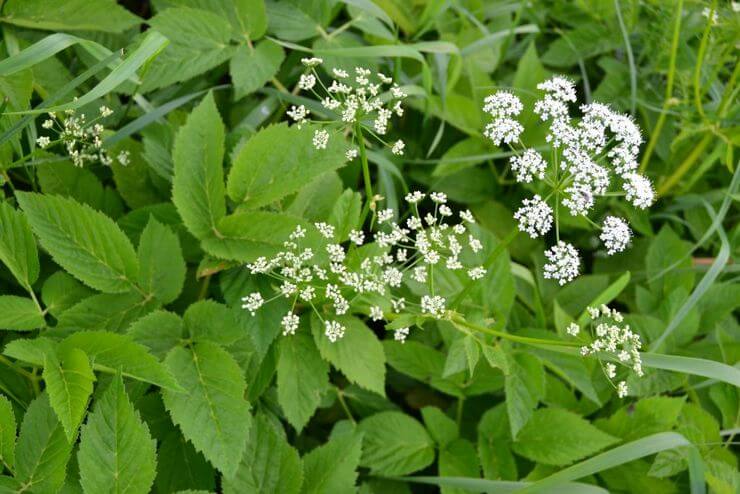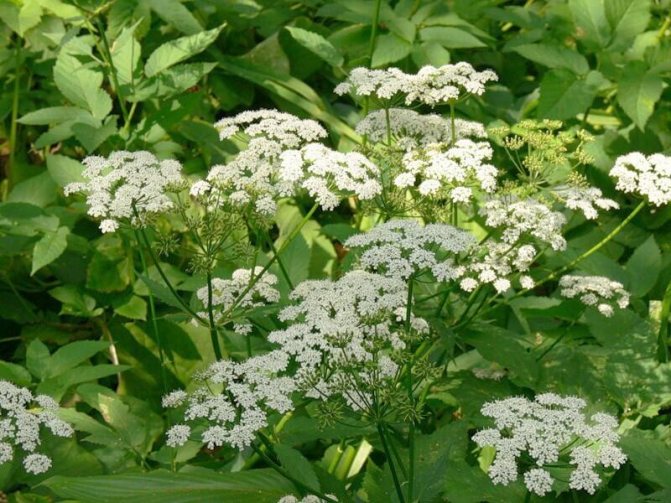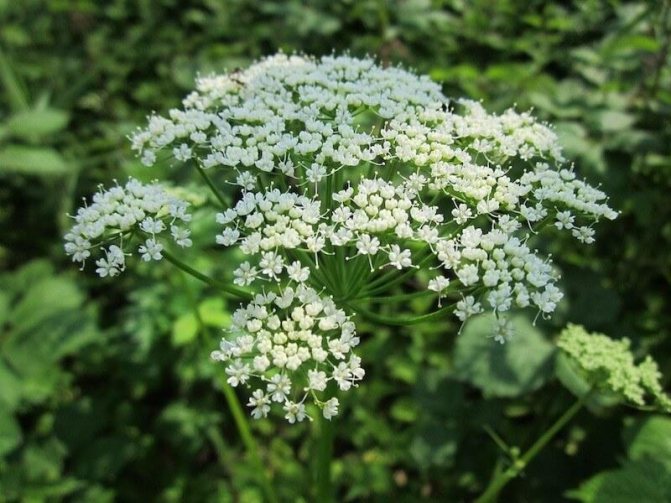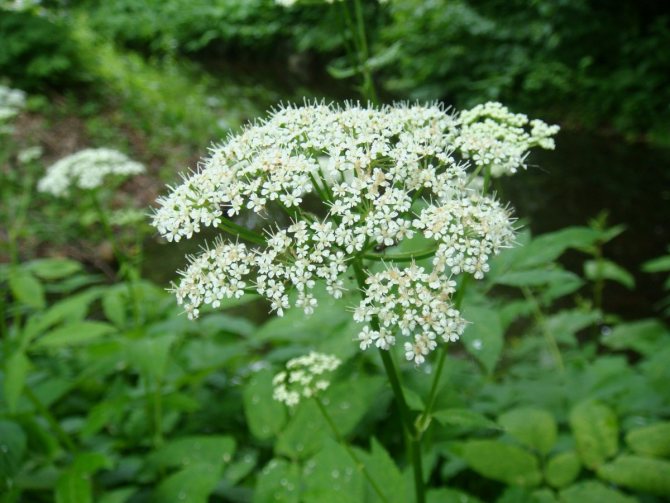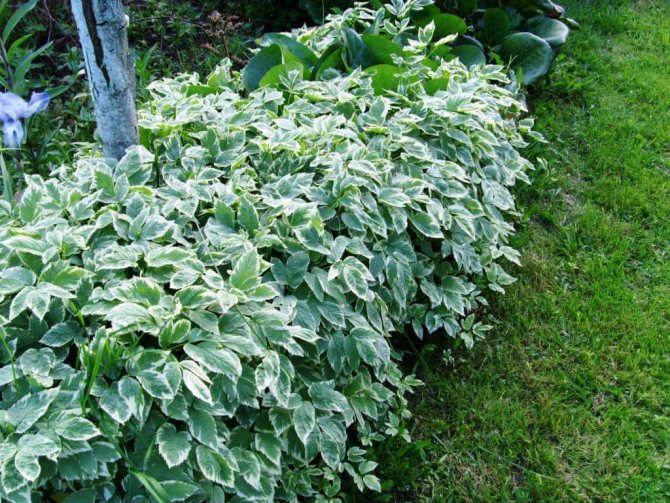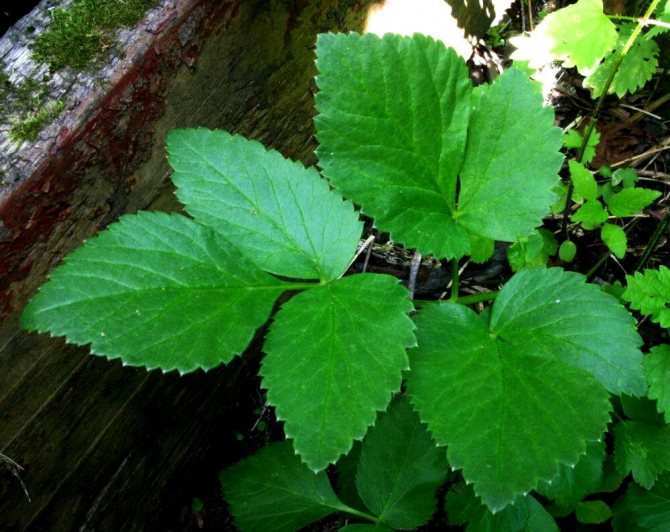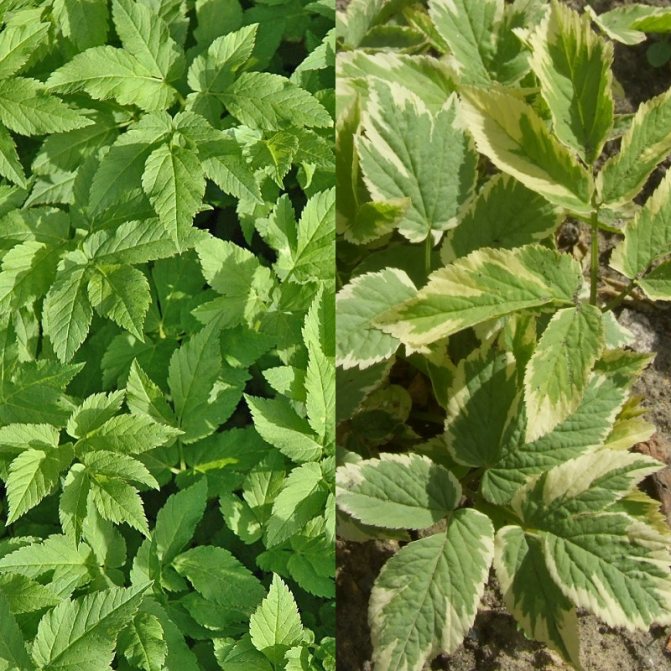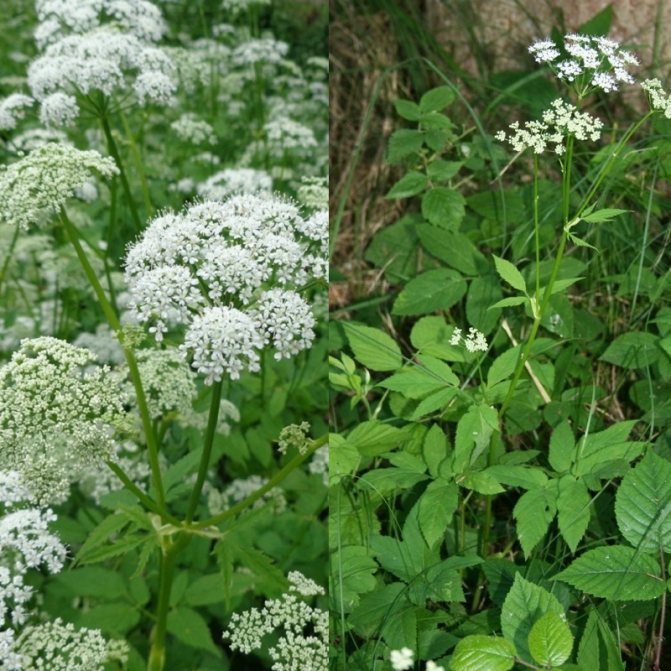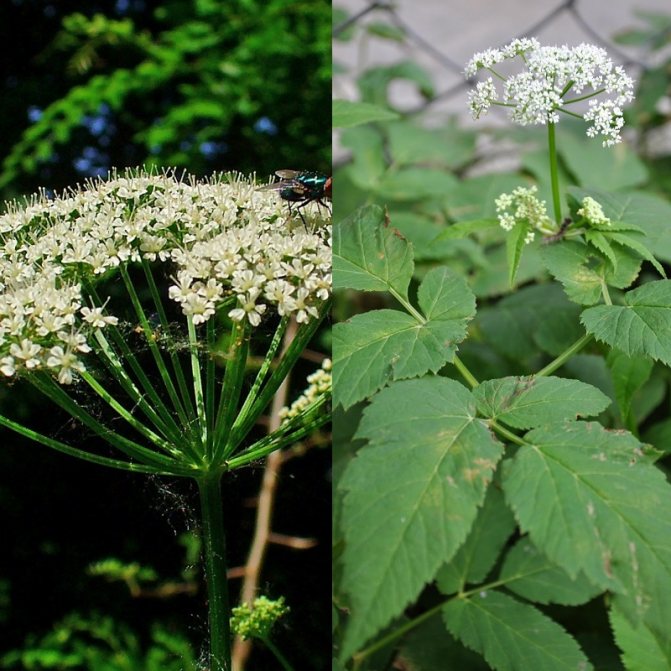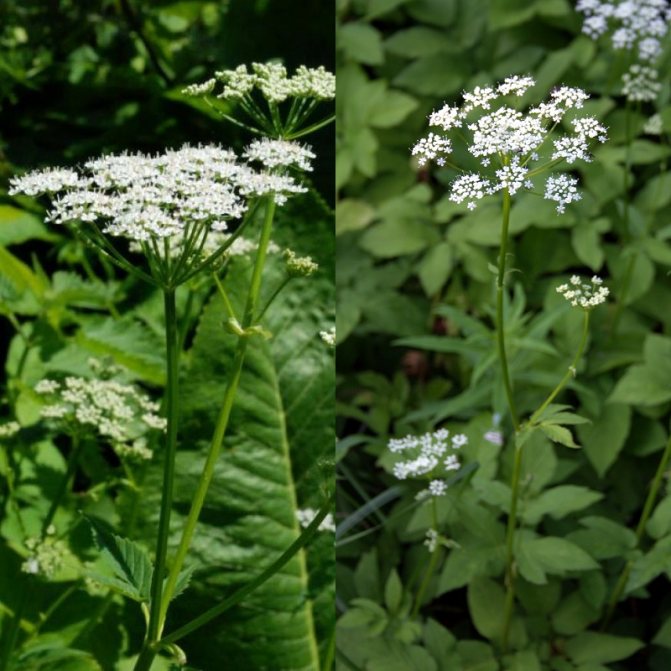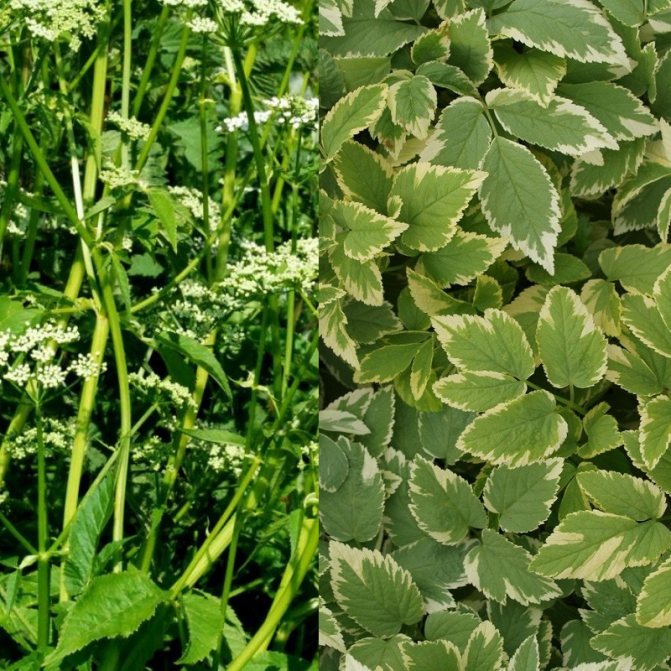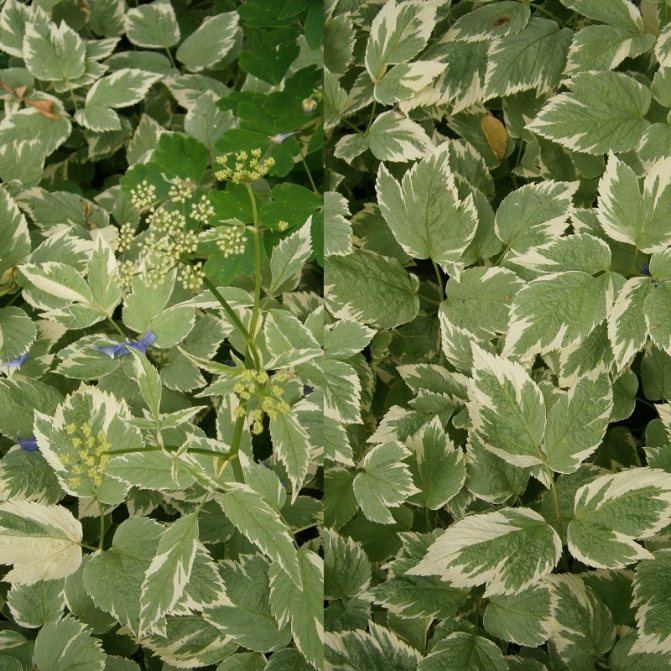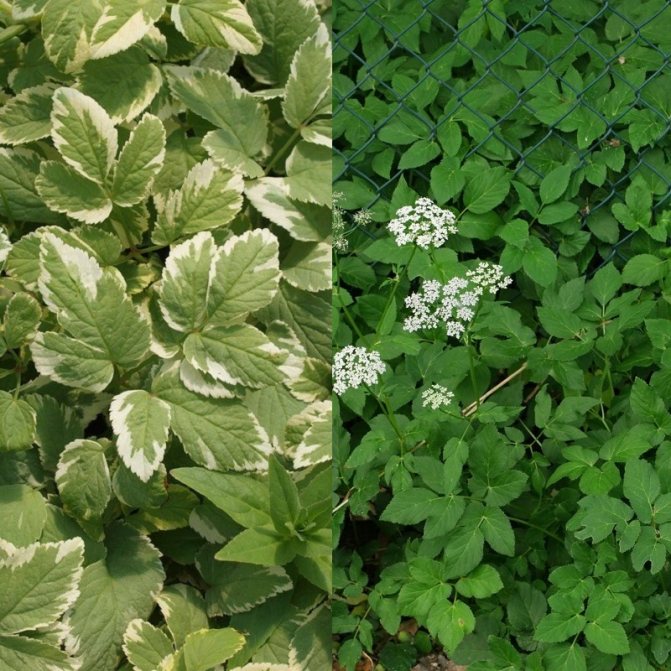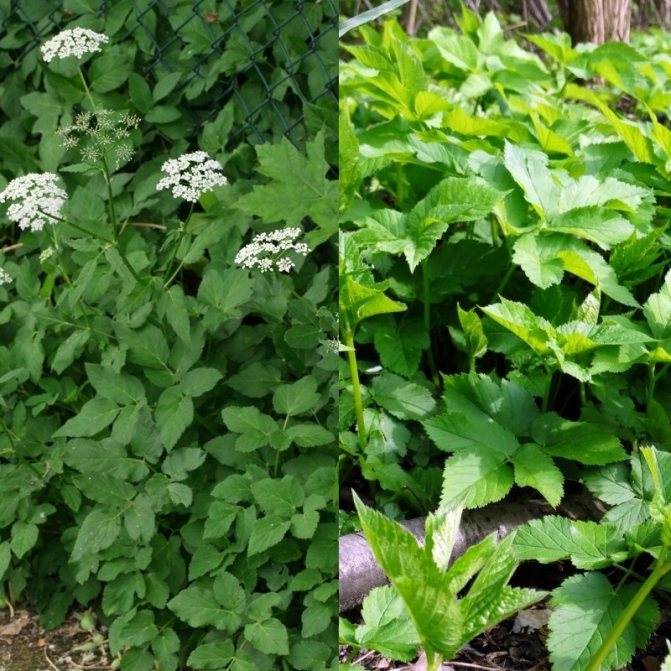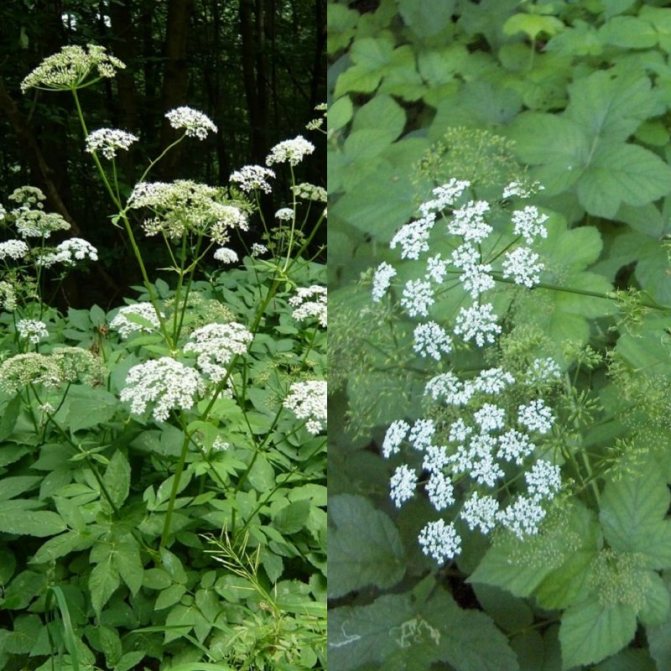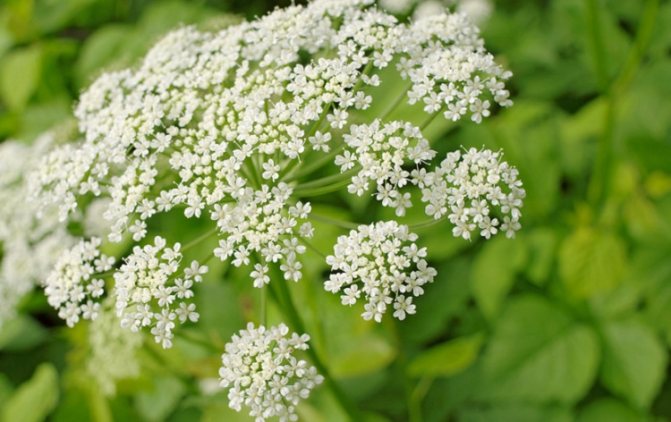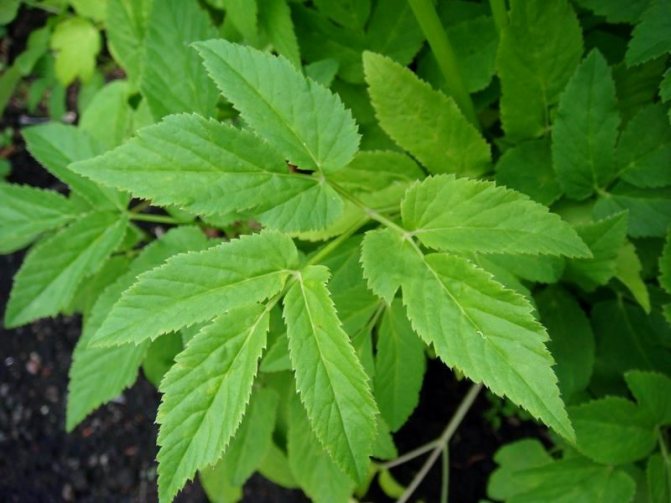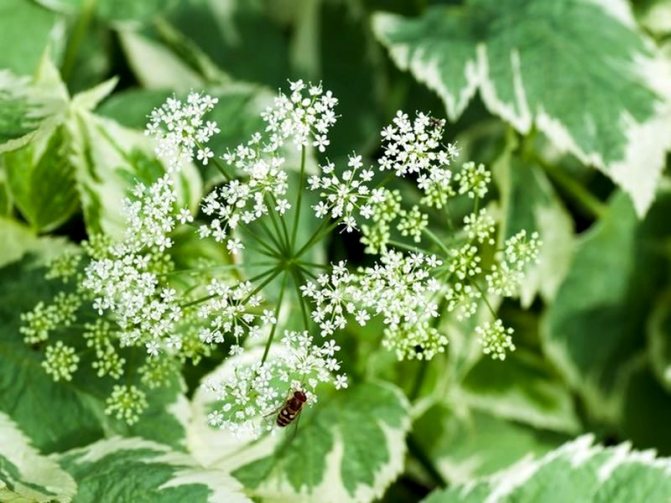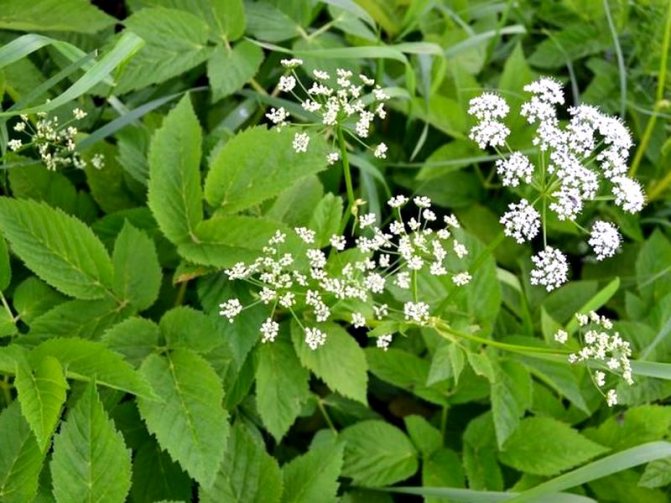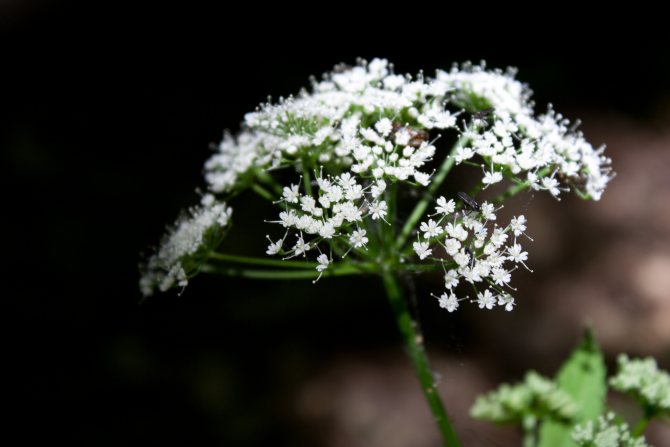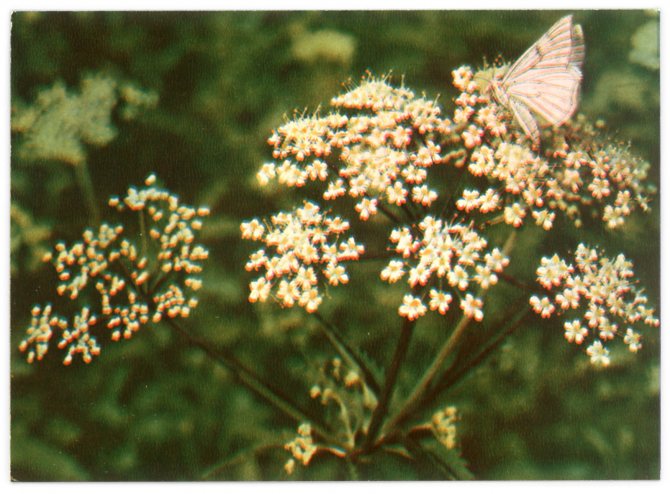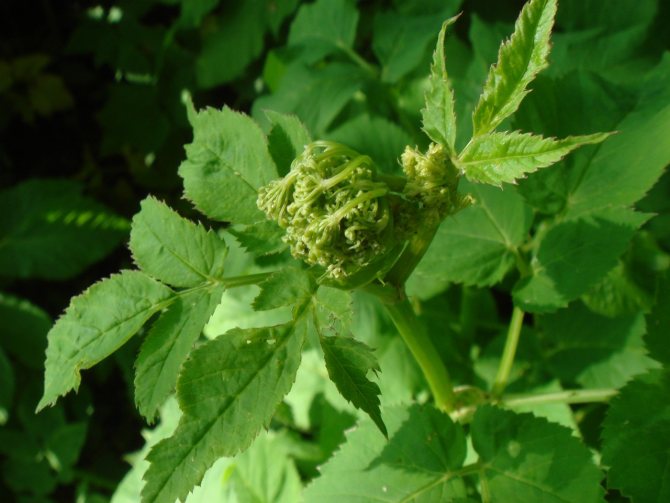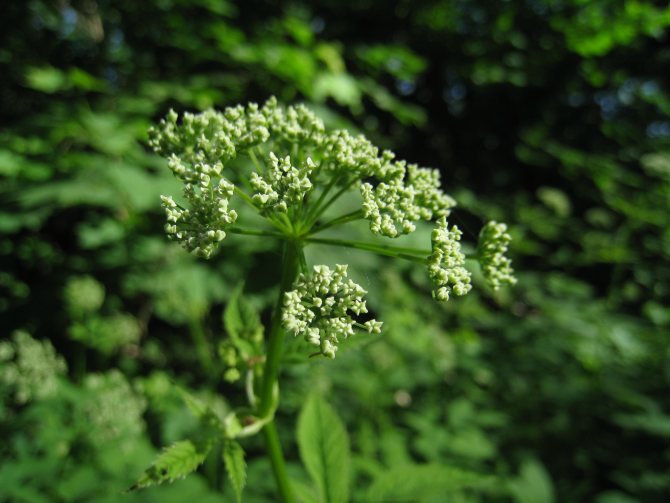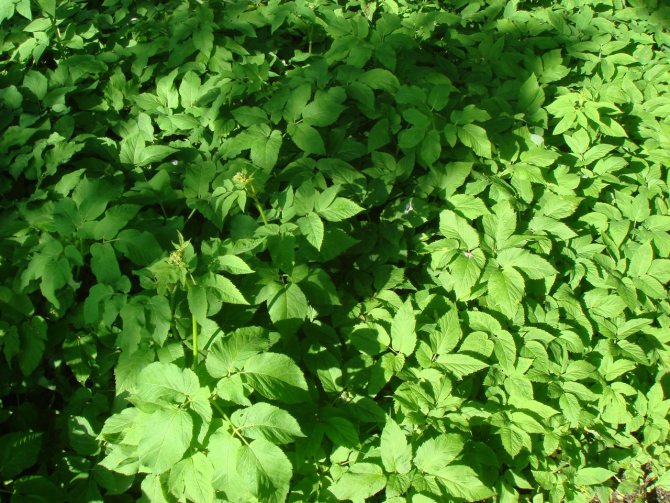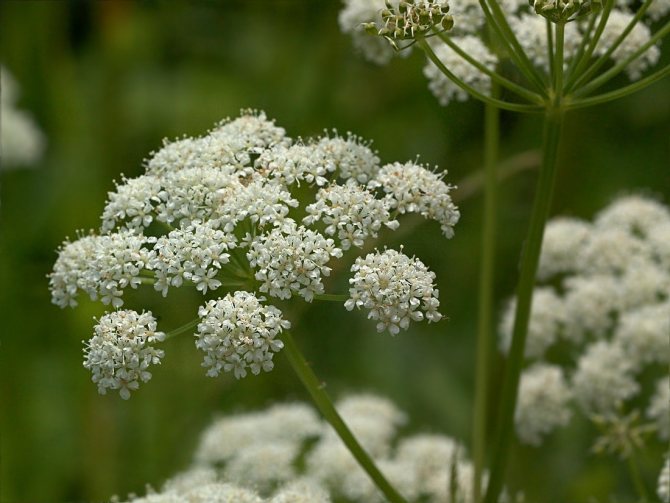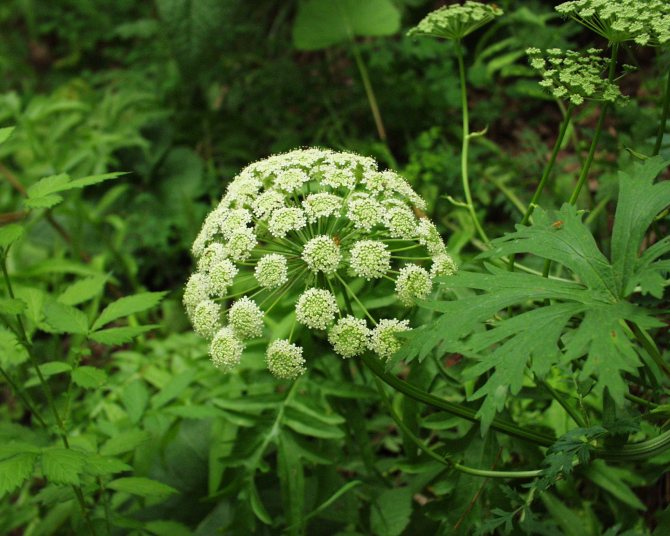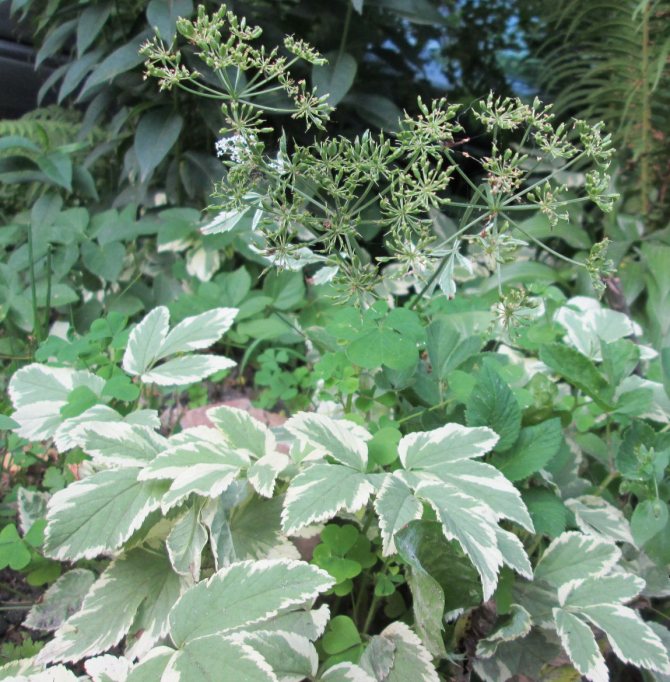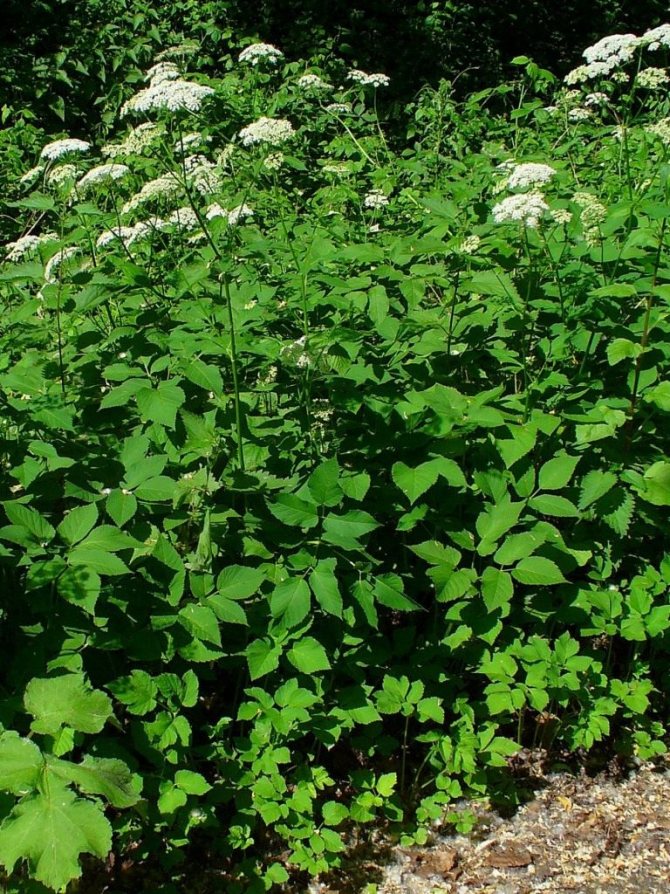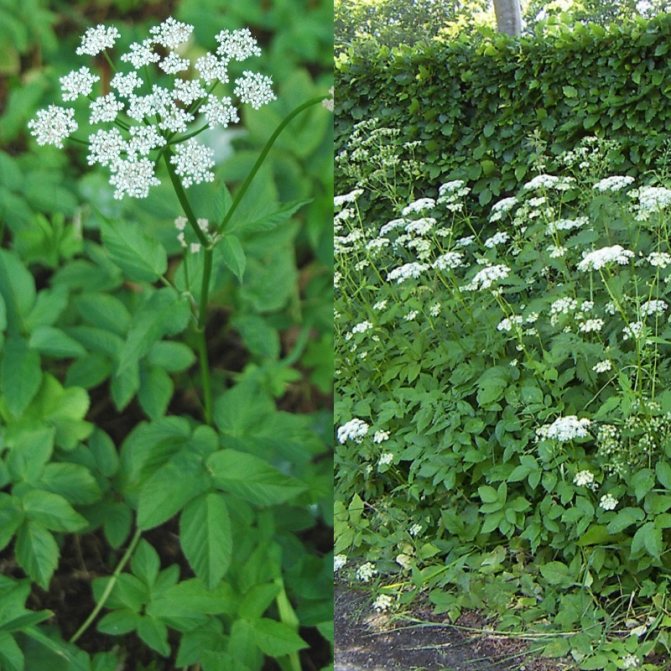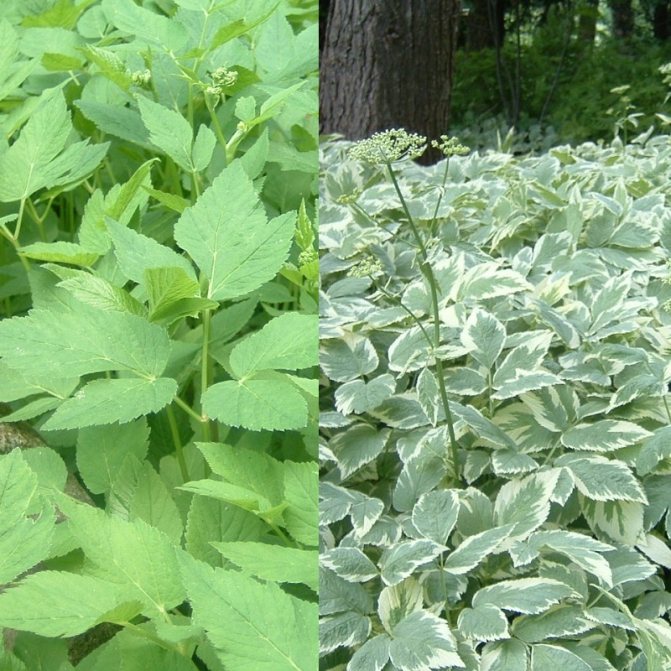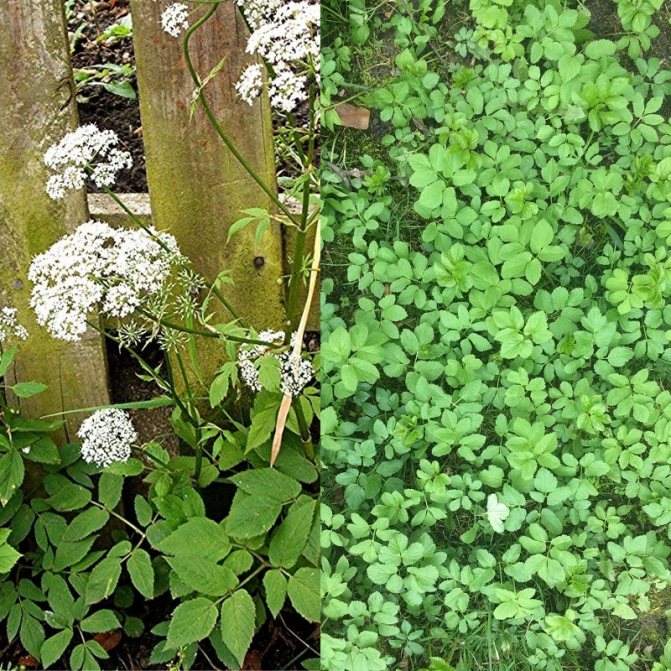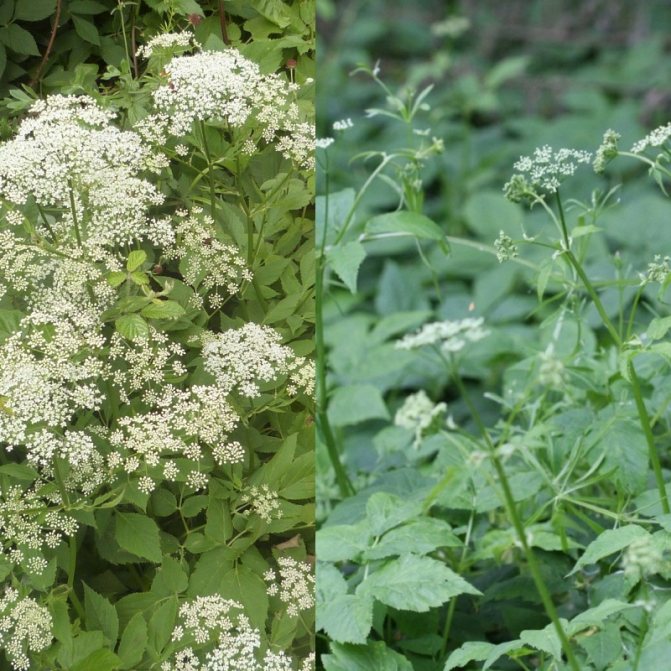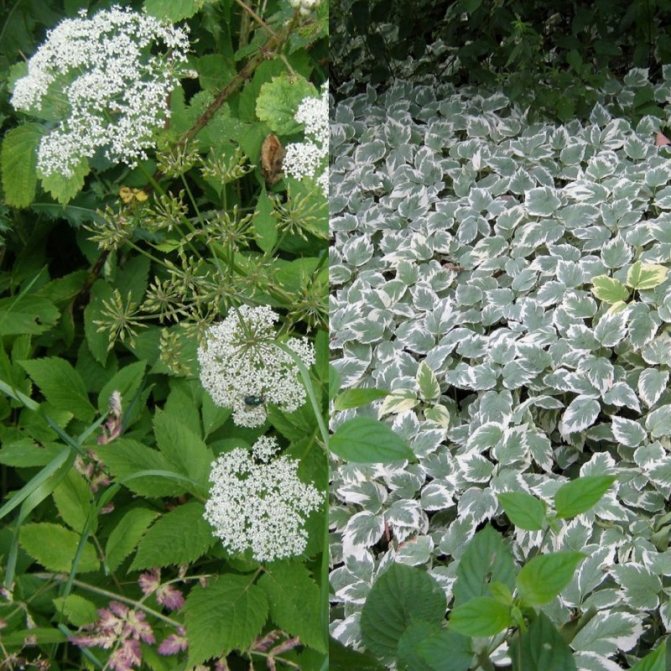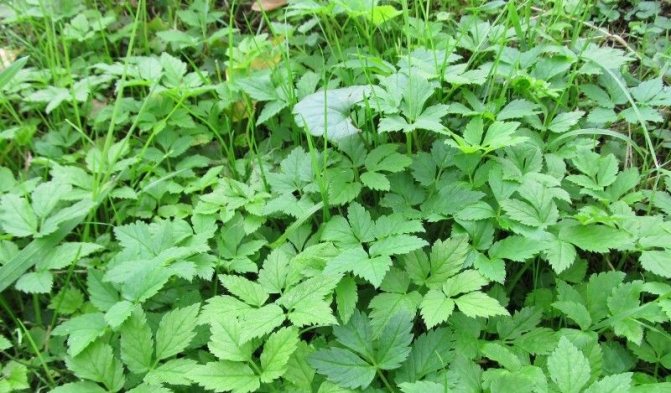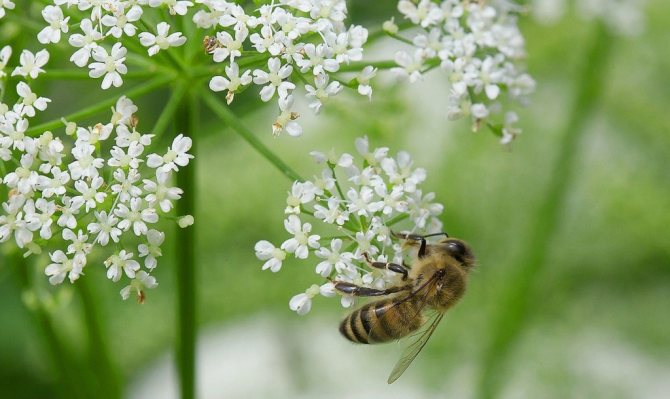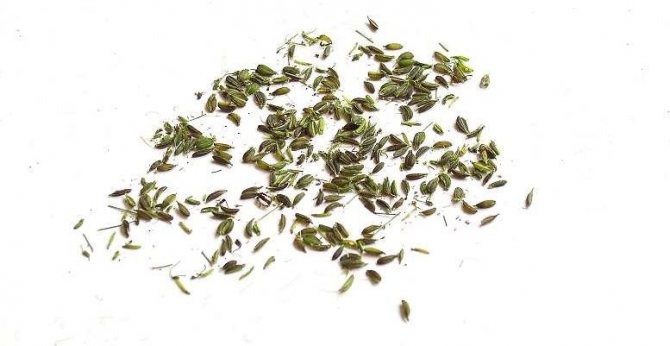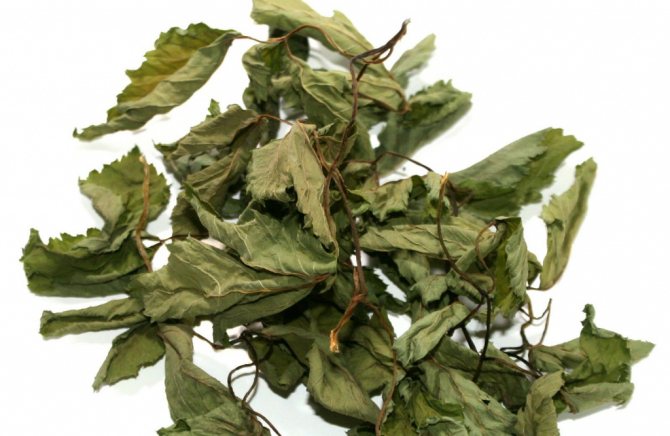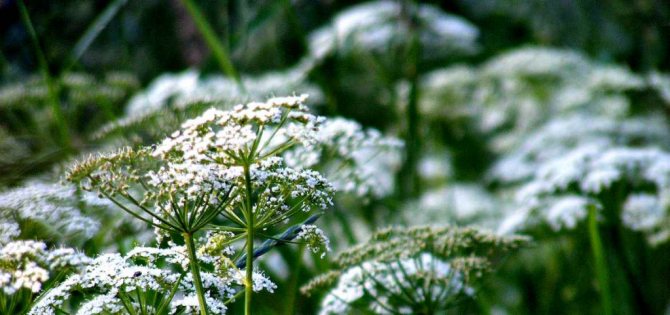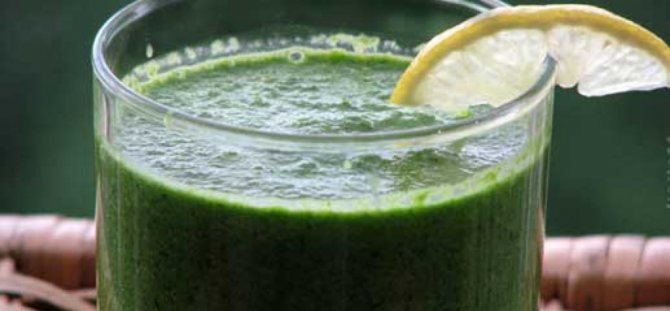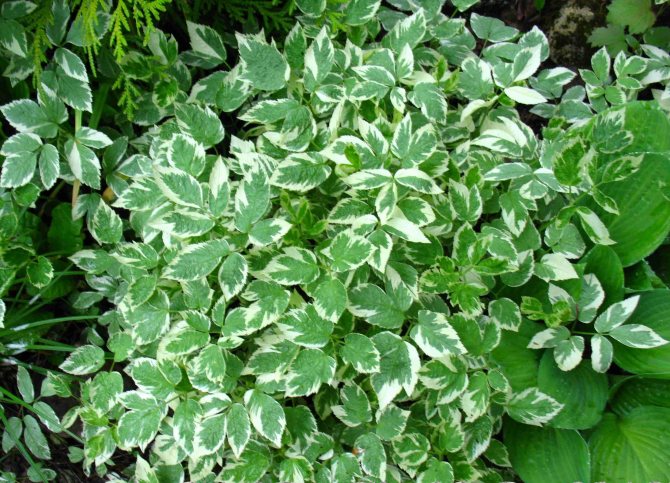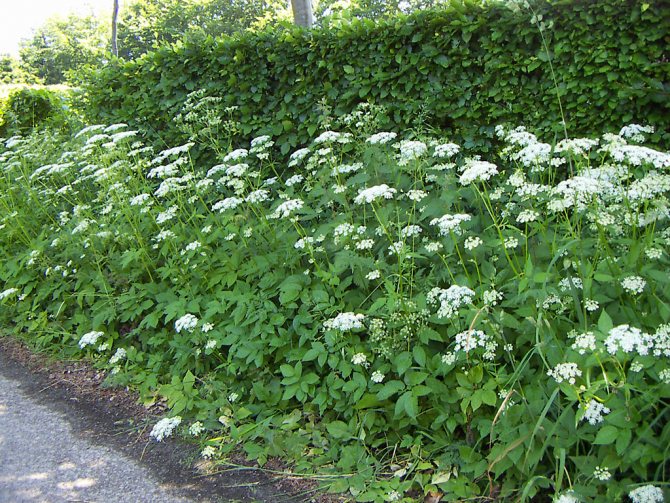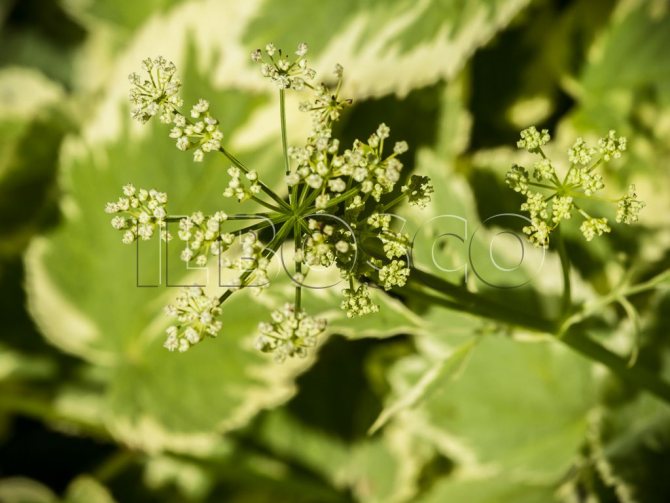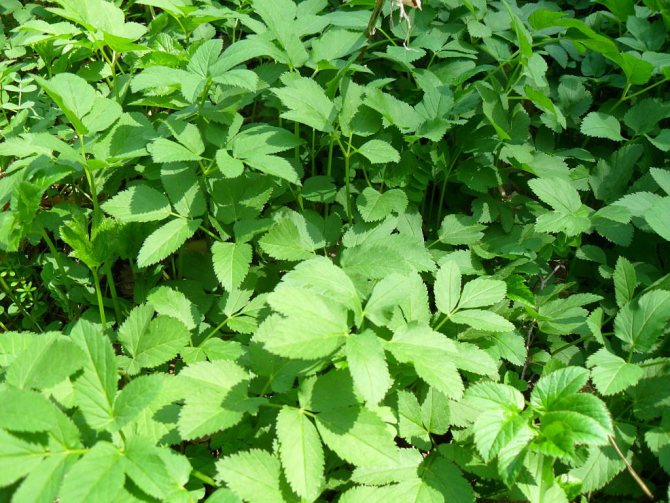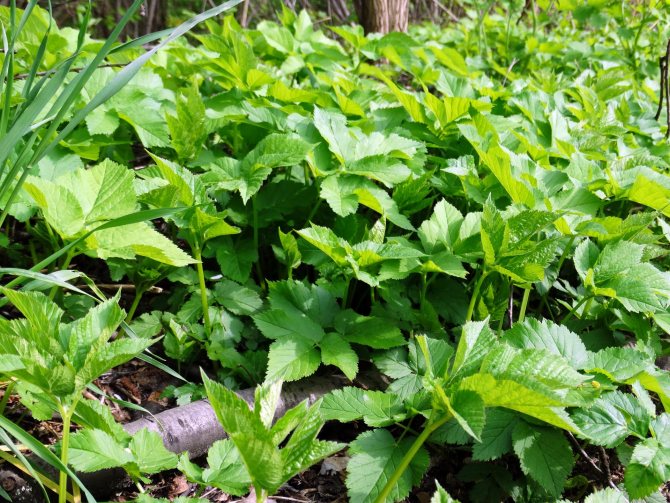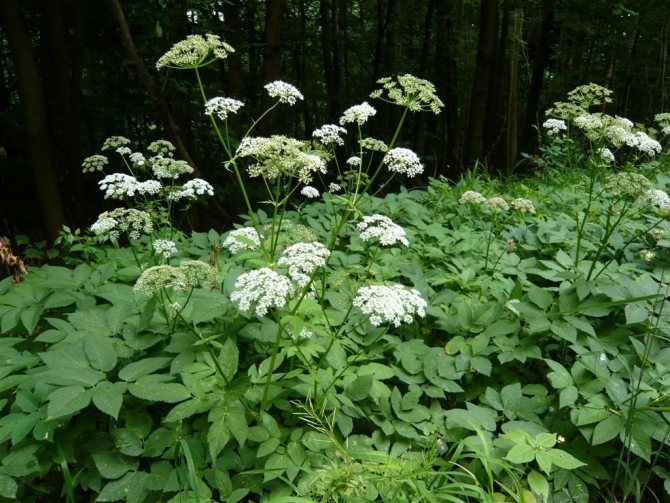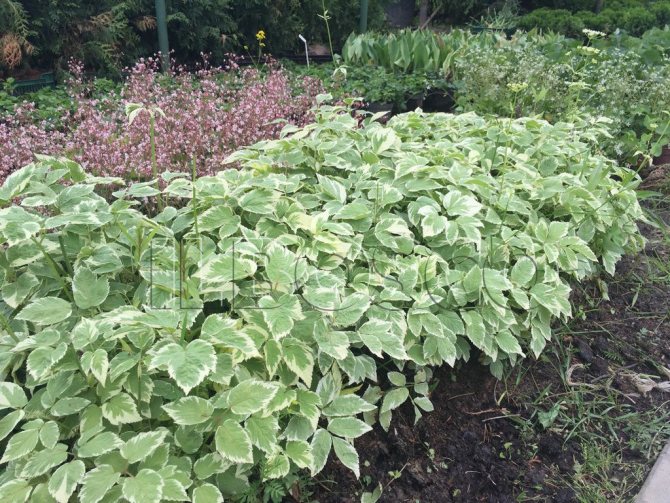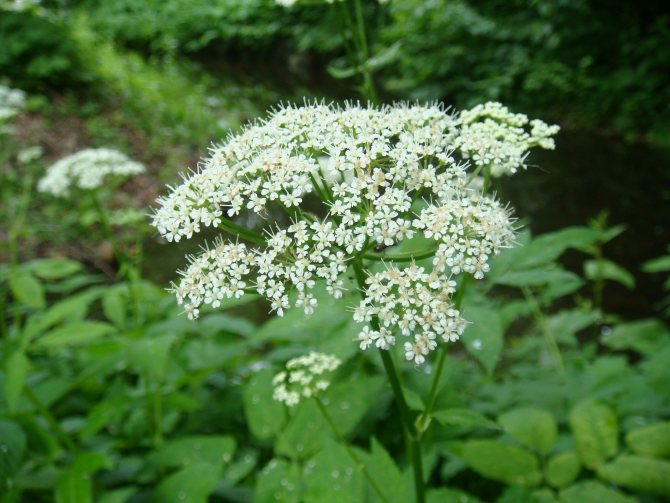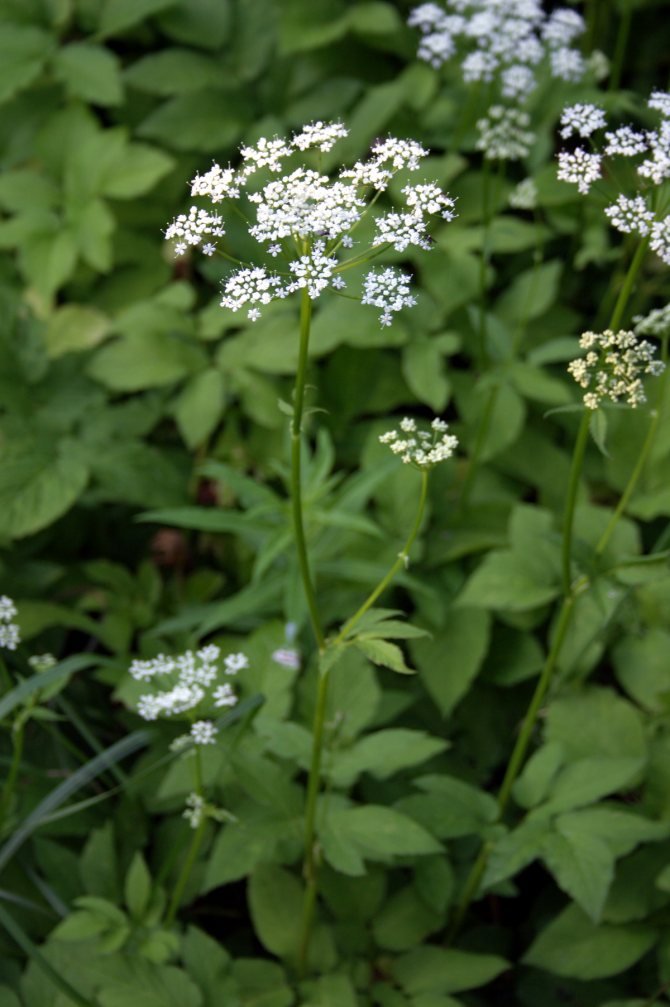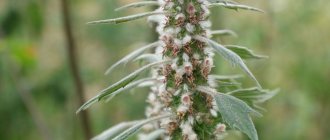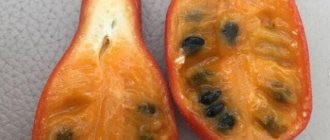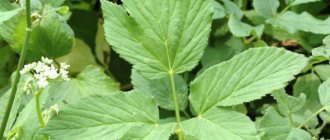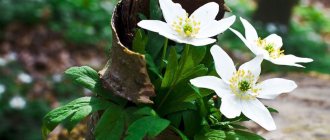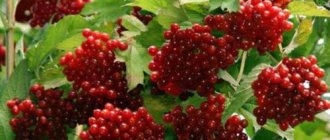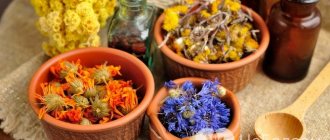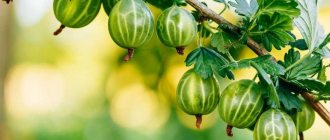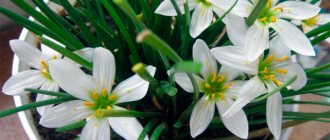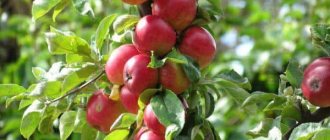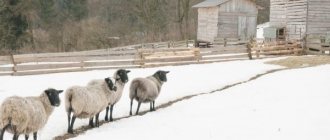What does the common whimper look like and where does it grow
Rhizome of horizontal type, creeping. The stem is straight, hollow and furrowed, somewhat branched at the top, no more than a meter in height. The lower foliage is twice trifoliate, the leaves are pointed and oblong-ovoid, no more than 80 mm long, with sharp-edged edges. The upper foliage is of a trifoliate type, located on shortened petioles, small in size. The foliage is almost naked above, and pubescent below. The venation is of the pinnate type.
The inflorescences are represented by a complex umbrella, consisting of two dozen flowers. The apical umbel is of a fertile type, and the lateral umbels are infertile. Flowers are small in size, white in color. The fruits are oblong flattened brown two-shrubs. The grass grows on rich soil mainly in deciduous or mixed forest zones, in clearings or among shrubs. Very often it is a common weed vegetation in vegetable gardens and orchards.
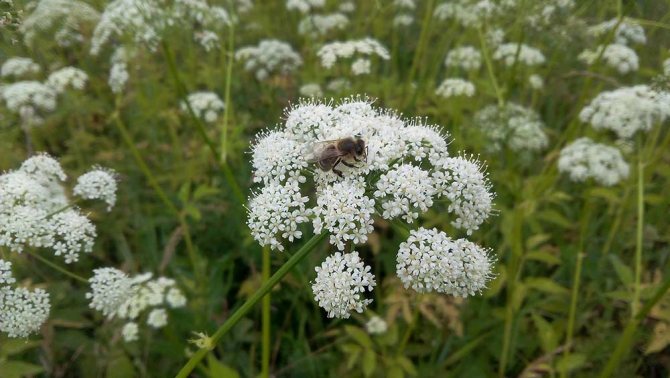
Common types
The typical species is the common runny, it has spread widely throughout our country. He is considered a malicious weed in horticulture and horticulture because, no matter how you get rid of it, it will still "creep" from neighbors or from another place. Scientists consider this species to be the most studied, it has a complete botanical description that does not require additions.
In medicine, common runny has also found its place, it is used in the treatment of certain diseases, since its trace elements give anti-inflammatory, antibacterial, anesthetic and other effects. In folk recipes for health, it is often mentioned in the formulations of remedies for gout and rheumatism.
The long horizontal rhizome grows very quickly, forming large bushes from numerous growth buds. Stems are long, furrowed, the plant can reach up to 70-100 cm. The erect shoot is most often glabrous, but can be covered with fine hairs. The stem branches at the top.
The lower basal leaves are large, divided into two ternate-plated plates. The petiole can reach 40-50 cm in length. The upper leaves are smaller, with short, expanding legs.
Large inflorescences up to 15 cm in diameter, consist of several umbrellas (usually 15-22). small shields are attached to the stems with short thin pedicels. The flowers are very tiny, white or pinkish. One bud has 5 stamens and 1 pistil. Only the middle part of the umbellate inflorescence reproduces, those scutes that are located on the sides are sterile and do not form fruits. The common runny blooms in early summer for about 30 days. In August, multifaceted small fruits ripen, flattened on the sides.
Broadleaf runny
The species of broad-leaved dream, listed in the Red Book of the Russian Federation, lives only on the southeastern shore of Lake Baikal. The plant grows up to 60-70 cm in height. The stems are tough, hollow inside, like a tube in section. The surface of the shoots is furrowed, without pubescence. The leaf plates in the root zone with large teeth along the edges, trifoliate, sit tightly along the main petiole, as can be seen in the photo of the dream. The inflorescences are large, can be up to 25 cm in diameter.This is a wide scutellum, consisting of small inflorescences of umbrellas up to 22 pieces. It blooms for 1 month at the beginning of the summer season.
Kashmiri dream
If the common species is considered a malignant weed, then the Kashmiri runny often becomes a favorite of flower growers. Unlike the first described specimen, this one does not grow so aggressively. Its root system is less spread. Gardeners love this species for its ability to create cute green carpets.
The foliage is dense, so it easily displaces other crops from the site. The Kashmiri runny blooms in the second half of summer, with small white flowers, collected in a looser complex umbellate inflorescence. In medicine, the species is not used, since it has no useful medicinal properties. It can grow up to a maximum of 30 cm in height, therefore it is more often used as a ground cover ornamental crop.
Medicinal properties and chemical composition of sleepiness
The plant has anti-inflammatory, astringent, healing, hemostatic, diuretic and choleretic effects, and also has analgesic, antibacterial and fungicidal properties and is used in detoxification. The plant is used in the treatment of:
- rheumatism;
- gout;
- polyarthritis;
- arthrosis;
- wounds, bedsores and other skin injuries;
- infectious lesions of a fungal and bacterial nature;
- depressive conditions;
- insomnia and other pathological sleep disorders;
- neurosis-like states
- iron deficiency anemia;
- diseases of the urinary system and kidneys;
- pathologies of the biliary tract;
- heart and vascular diseases;
- atrophic ulcers;
- weeping eczema;
- benign tumors;
- scurvy.
Types and varieties of sleepy with photos and names
How ornamental plants grow the following types of slime:
Alpine runny (Aegopodium alpestre)
This species is resistant to drought, while the bush reaches a height of about 50 centimeters. His homeland is Central Asia. The openwork umbrella-shaped inflorescences include white small flowers. Greenish leaf blades are finely cut.
Runny variegated (Aegopodium podagraria Variegatum)
Both the previous and this species are less aggressive in comparison with the common despair, because if you start growing it on the site, then most likely you will not get rid of it. But most gardeners specifically sow this species for the medicinal properties that it possesses.
Photo gallery
How to distinguish whiteheads from other plants (video)
The components of the plant are also characterized by a pronounced sedative effect, contain a sufficient amount of carbohydrates, cyclitols, lectins, coumarin, steroids, as well as basic nitrogen-containing compounds.
The foliage, stem and root system contains a sufficient amount of vitamins, amino acids, flavonoid compounds, essential oils, and minerals, including iron, potassium and calcium, silicon and phosphorus, magnesium and molybdenum, aluminum and copper, and zinc. Also in plant raw materials it has a high amount of polyacetylene compounds, fatty and organic acids.
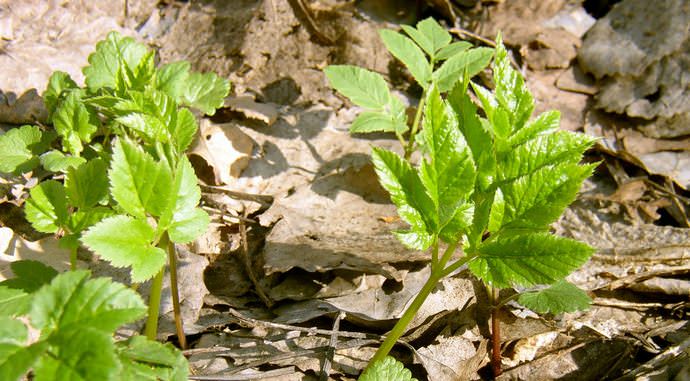

Growing and caring for snow on the site
It may seem strange, but some gardeners are interested in how to grow the willow in their garden and what kind of care it requires. In fact, the plant is extremely picky, only if it is not a broad-leaved species. It is a very common perennial for cultivation in pharmaceutical plots, from where it spreads to other vegetable gardens as a malicious weed. Many gardeners scold those who grow whitewash on purpose, but you should not do this, it is better to read about its beneficial properties above and you may want to plant it yourself.
In order for the plant not to multiply extremely quickly throughout the garden, a special bed must be set aside for it. Let's call it “pharmacy department”.Experienced growers know how to prevent self-sowing, you need to prevent the ovary of the fetus. They do it in only one way - cut off the inflorescences. But, in the case of sloughing, the flowers can be pollinated among themselves and without sap flow, that is, cut off, therefore, after pruning, they must be immediately disposed of or destroyed.
Rhizomes do not go deep, but spread to 20-30 cm depth under the surface of the soil. Therefore, before planting, dig in the fence for the garden bed. These should be rigid, non-decaying boundaries. Planting dream is very simple - just sow seeds or plant part of the rhizome with a point of renewal in spring or autumn before winter.
The most important nuance of care is the removal of inflorescences so that the plant does not spread throughout the garden. If you want to get rid of plantings, then try to remove the entire rhizome so that there are no parts left with the bud of resumption of growth. Near the garden, try to note for yourself all herbaceous dreams and remove flowering inflorescences from them, as they can spread naturally throughout the site.
Healing recipes of traditional medicine using dream
For pathologies such as rheumatism and gout, diseases of the urinary and renal system, inflammatory processes in the joints, infusions based on sleepiness are used. To prepare such an infusion, you need to pour a couple of tablespoons of sleepy with a glass of boiling water, then boil for about a quarter of an hour and strain. Then a glass of boiled water at room temperature is added to the strained infusion. The infusion is used one glass per day.
With rheumatism, gruel gives very good results.obtained from crushed leaves. Such gruel is applied to the affected areas and replaced with a fresh portion as needed. With neuralgia, myositis and chronic fatigue, it is necessary to take special relaxing baths, which contain a decoction based on the root of sleep. Outwardly, lotions based on fresh leaves of dream is used, if necessary, to quickly and effectively get rid of acne and festering wounds, boils and other skin diseases.
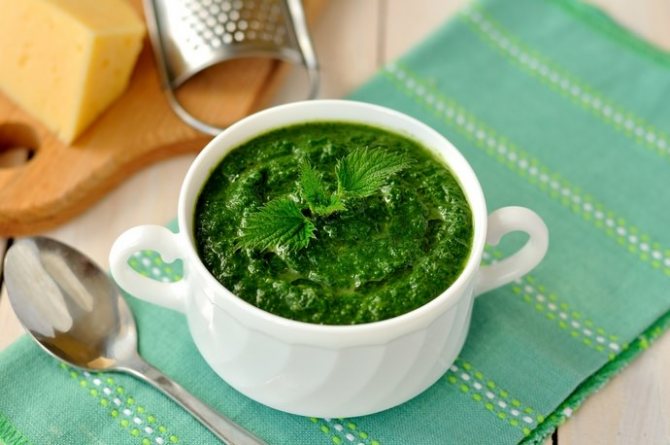

External use
Compresses from freshly cut leaves, lotions from infusions, decoctions and alcoholic tinctures are successfully used for neuralgia, for the treatment of gout, rheumatism and other joint ailments. Fresh juice can be used to wipe problem areas, leaf gruel is recommended to be applied in the form of a medical bandage, and slightly warmed essential oil is used to massage deformed joints.
Healing bath
A relaxing snuff bath will help you relax and release tension after exerting stress on your muscles. The effect of a therapeutic bath is also effective for various neuralgias, the treatment of which includes warming up the diseased part of the body. It is best to carry out the procedure before going to bed, in about 15-20 minutes. This will not only contribute to a quick and strong fall asleep, but also relieve pain in myositis, neuralgia and arthritis of various origins.
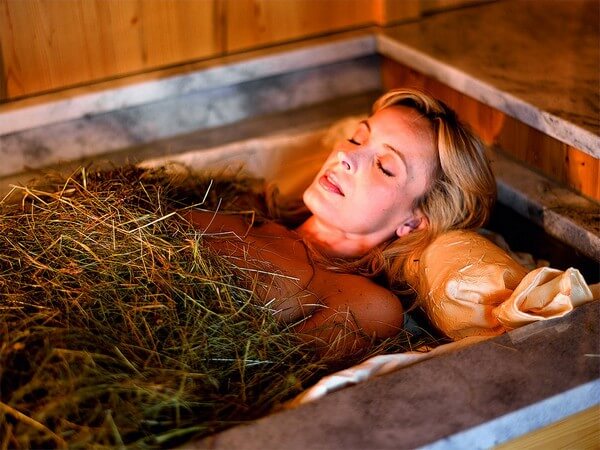

A medicinal bath with flush is made as follows: clean 50 g of flush roots, finely chop and pour one liter of boiling water. Boil over low heat for 10 minutes, close the lid and let it brew for about half an hour. Filter through cheesecloth and pour the broth into the bathing water, making sure that the total temperature of the liquid does not exceed 37-38 ° C.
Dream compresses
The easiest method to use to relieve inflammation, swelling and pain in joints is to grind fresh leaves and attach them to the deformed joint.The analgesic substances contained in the plant penetrate the skin and relieve pain.
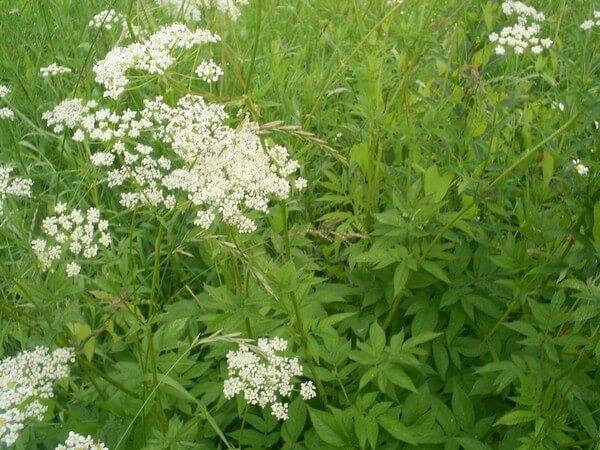

With myositis (inflammation of muscle tissue), it is most effective to make lotions with crushed plant roots, and in case of various skin inflammations, lubricate them with clean fresh juice.
Dream oil compresses, mixed in equal proportions with other refined vegetable fat, are good for rheumatic swelling and neuralgia. And for the prevention of arthritis in the very first stages of the disease, natural therapists advise rubbing the essential oil of the herb into the affected areas. Such a procedure helps to relieve stiffness during movement, relieves swelling of the joints, pain, and other unpleasant sensations associated with diseases.
Dreaming about cooking
Dishes made from greenery are not only tasty, but also extremely healthy.... They allow you to quickly get rid of vitamin deficiency, as well as strengthen the immune system well. Such a widespread plant in our country contains a large amount of vitamin "C" and carotene, and is also rich in various protein substances and many mineral salts necessary for the human body.
Young leaves of a garden plant are often used for the preparation of salads and vitamin green cabbage soup, sauces and okroshka, as well as vegetable cutlets. Experienced housewives stew the green foliage with potatoes, and ferment or pickle it for the winter. It should be noted, that green cabbage cabbage soup in taste characteristics is absolutely not inferior to traditional cabbage soup.
The uniqueness of the plant
The nutritional and healing properties of the herb under discussion were already known in Russia. It is interesting what exactly Seraphim of Sarov has been eating for many years. This was the only product that the monk used. Grass salads were also served in canteens in the capital during the Second World War. And today many gardeners even consider to be a weed at all and mercilessly get rid of it.
Botanical description
Snow is a herb of the Umbrella family. This is a plant with a straight stem, pointed leaves. It can be up to 1 m long. The plant blooms with small snow-white flowers, collected in lush umbrellas. They appear in early and mid-summer. After the flowers, miniature brown fruits are formed.
The herb in question is common throughout the European part of Russia. You can also find it in the south of Siberia, in the Transcaucasia, Central Asia, in eastern Europe. The plant comes across in mixed forests, along roads, among bushes. And, of course, in the gardens.
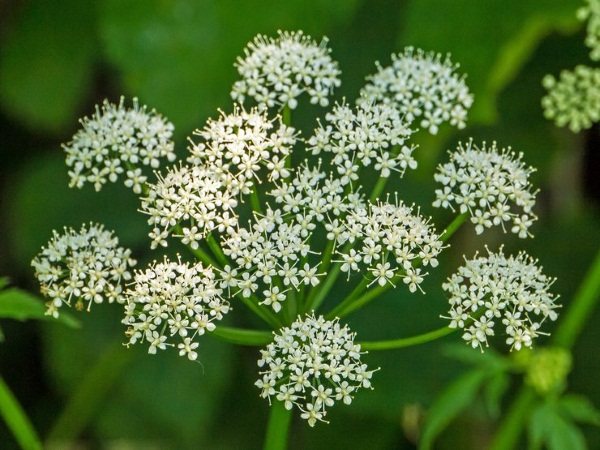

Summer residents extremely do not like to run away, since it has long and creeping rhizomes. The plant is able to quickly spread throughout the summer cottage and even displace garden crops. For example, cucumbers and tomatoes. Therefore, the owners of the territory usually ruthlessly weed out the plant, not knowing that it is very beneficial to health when used correctly.
It is believed that the unusual name of the herb originated from the word "food" - "food". This is because such a plant can be safely eaten without fear of poisoning and other negative consequences.
Even the ancient Romans brought them to the British Isles and sowed vast territories with it. Then the grass was planted as a forage crop. In the future, the plant also began to be used in folk medicine.
Today, beekeepers are especially fond of running away and actively planting areas adjacent to the hives with it. More than 220 kg of high quality honey can be harvested from 1 hectare of flowering plantations in just 1 season. It turns out to be especially aromatic and healthy.
What parts are used for medicinal purposes
Sleep, the medicinal properties of which are well known to folk healers, is used to treat a variety of ailments.The most important feature of the herb is that it does not accumulate in its parts toxic and any products harmful to humans.
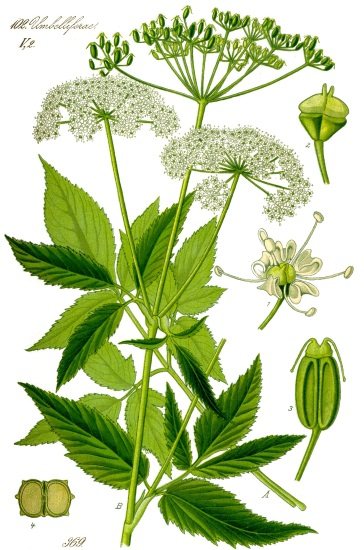

| Plant parts | Features and useful properties |
| Stems | They contain a large amount of vitamin C, choline, carotene, essential oils, numerous macro- and microelements. These parts increase human immunity, help with kidney problems, gout, diabetes. |
| Seeds | Biologically active substances from their composition remove carcinogens from the body, stop the growth of cancer cells |
| Greens | There is a huge amount of vitamins (especially C) and trace elements in the leaves of the dream. It is recommended to eat it - add it to a salad fresh, stew, mashed for a side dish, cook soup from them |
| Dream tea (blend of plant parts) | The drink is brewed from a mixture of different parts of the dried plant. Ready tea regulates the intestines and restores the water-salt balance in the body |
| Roots | A decoction from the roots of the herb quickly lowers blood cholesterol levels. It is also used to treat polyarthritis, myositis. |
In order for medicines or dishes from any part of the dream to bring exclusively benefit to the body, they must be prepared and consumed strictly according to the instructions. It should also be remembered that the raw plant is a powerful laxative.
Collection
If the runny is going to be eaten, then it is best to do this before the plant begins to bloom. During this period, the leaves, petioles, and shoots are juicy, tender. Later they get rough and start to taste bitter.
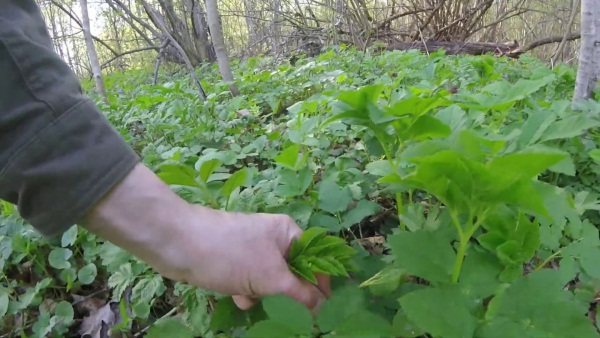

If the runny grows in its own garden area, then you can extend the time for collecting the grass. To do this, even at the initial stage of formation, you will need to cut out the inflorescences.
Old tea leaves are also allowed to be used in traditional medicine. They need to be harvested and dried. And in the future - to brew tea from the resulting raw materials. The upper parts of the stems are dried along with the leaves.
You need to collect snow away from railways and highways. For example, in the depths of parks. You can often find thickets of such grass around monasteries. Previously, a large number of plants were specially planted on their territory in order to further use it for medical purposes.
Sleep, whose medicinal properties are known throughout the world, has several close relatives at once. Among them, for example, cicuta and hemlock. These are plants that are known for their deadly poisonous effects. They look like edible runny outwardly, but at the same time they are strictly prohibited for consumption.
In order not to be poisoned, you need to be able to distinguish a useful plant from a poisonous one. The common snake has long oval leaves with a light downy down and smooth ones on the top. The lower leaves are located on long petioles, the upper ones on short ones.
In a poisonous herb, leaves in appearance resemble carrot or parsley. They are feathery, finely dissected. Such plants should not be tried even in the smallest dose. Their use leads to serious poisoning.
How to prepare
Since access to fresh grass is only a few months a year, and for medicinal purposes it can be used regularly, it is worth taking care of the correct preparation of the plant for the winter in the summer. To do this, you need to choose a day with sunny dry weather. If there is no slump in your own summer cottage, you need to go to collect it away from garbage dumps and highways.
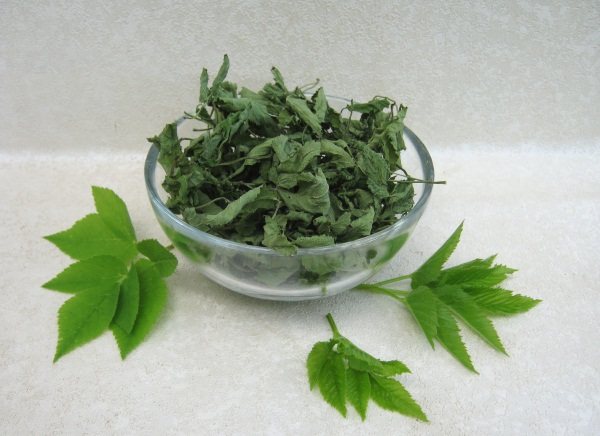

It is important to remember that the grass in question should never be wetted before drying.
Therefore, you need to choose very clean places for collection in order to immediately send the raw materials for drying. If the grass grows in a summer cottage, you can thoroughly water it with clean water a couple of days before harvesting, removing dirt, and then let it dry completely.
It is best to harvest only the stems and leaves, cutting them off with scissors or tearing them off with your hands.Inflorescences do not need to be used.
For drying, the collected parts of the plant are laid out in dry and warm, but regularly ventilated rooms. If possible, it is worth scattering the grass directly on the street, but in the shade or under a canopy, and make sure that there is no rain. It is better to lay out the raw materials in a thin layer on a natural fabric, cloth or paper. Be sure to stir it periodically. This will speed up the drying process.
Storage
It is believed that the raw material is completely dry when the stems of the dream begin to break without effort, and the leaves begin to crumble. At this stage, it remains to grind the plant and send it for storage. Paper bags or bags made of natural fabric (for example, canvas) are best suited for "wintering" dry snow.
Store the herb in a dry, dark place. The room temperature is not important. Therefore, you can send bags or packages with muck to any closet or leave it in the attic in the country. It is permissible to store the prepared raw materials no more than 2 years.
How to cook snake (video)
To prepare green cabbage soup, rinse and chop the young one, then pour it into boiling water or broth and cook until half cooked. Then you need to add potatoes and onions, cut into strips, salt and any spices. The dish is served with half a hard-boiled egg and sour cream. For 200g. leaves will need to prepare 200g. potatoes, 20g. onions, 20g. oils, as well as spices and salt to taste.
The botvinia from sorrel and snow has a very original taste. For its preparation, it is necessary to rinse the young leaves of plants well, and then boil in a relatively small amount of water. The resulting broth is drained, and the boiled greens are wiped through a sieve and diluted with ordinary kvass, after which ingredients in the form of green onions, fresh cucumbers or cucumber herbs, as well as dill and parsley, need to be added to the botvin.
Chopped boiled egg and sour cream are added to a completely prepared dish. For 500 g of snow, you need to prepare 100 g of sorrel leaves, three or four fresh cucumbers or 300 g. cucumber herb, 200 g of green onions, half a dozen eggs and a couple of liters of kvass. Sour cream, salt, sugar and herbs are added to taste.


Growing dreamy in the garden
Sowing rules
They are sown in open ground in the same way as other herbaceous plants. Sowing seeds is carried out in spring or before winter. The area chosen for this plant must be limited in order to prevent its uncontrolled spread throughout the garden area. To limit slithering along the perimeter of the site, it is necessary to dig in slate or sheets of iron, while they should go into the soil by at least 0.3 m.In order to decorate your site with decorative slush, you should buy its seedlings in a garden pavilion or a flower shop. To begin with, they must be planted in containers made of iron or plastic, at the bottom of which there are holes for drainage. And then these containers are dug into the ground in the area designated for this plant. This culture grows well under trees, as well as in shaded areas. It should be borne in mind that in a well-lit area, the variegated variety will not be very attractive.
Dullness care
Watering should be systematic. In a dry season, the frequency of watering is increased, but at the same time it must be necessarily moderate. All species and varieties that are decorative need systematic pruning for sanitary purposes. For this, dried, injured and diseased stems are removed. In order to rejuvenate such a herb, it is recommended to completely mow it. In order for the bush to remain attractive, it is necessary to cut off the peduncles with inflorescences that have begun to form in a timely manner, otherwise the plant will degenerate into a wild-growing form, from those seeds that have spilled onto the surface of the soil, only an ordinary one grows.
If the snow is cultivated in poor soil, then in the first summer weeks it is recommended to apply mineral fertilizers or organic matter to the ground. But at the same time, one should be careful not to overfeed the bushes, but at the same time such a grass will be able to grow quite normally without fertilizing the soil. Such a culture is frost-resistant, while it is able to withstand a drop in air temperature to minus 39 degrees. You do not need to cover the bushes for the winter.
Diseases and pests
In some cases, spider mites or aphids can settle on the dream. This is usually observed during an extended dry period. If foliage begins to curl on such grass, then it should be carefully examined, since it is quite possible that you will be able to make out harmful insects. In order to get rid of such pests, the bushes are sprayed with a solution of Matcha, Aktellik or Aktara.
Read also: Spring wheat yield per hectare
Such a plant can also be affected by a fungal disease, for example, powdery mildew or anthracnose. For the treatment of diseased bushes, it is necessary to use such fungicidal agents as: Horus, Radomil Gold, Skor, Maxim, etc.
Harm and contraindications to the use of the plant
Despite the fact that runny has a very large number of useful properties, along with other medicinal plants, it has some contraindications for use, which must be taken into account:
- a relatively rare, but still existing contraindication is represented by individual intolerance to individual components of sleep;
- it is not recommended to use such herb in any form during pregnancy and lactation, as well as to use it to treat children of younger preschool age;
- it is extremely important not to self-medicate, and not to replace drugs prescribed by the attending physician with folk remedies based on sleep.
Despite the fact that, in its chemical composition, such an herb as runny is very close to the formula of human blood, it is absolutely impossible to use medicines based on it constantly and uncontrollably. Very important in the process of treatment and prevention, take short breaks, after which the use of the medicinal plant can be resumed.
Description of dream
In this section, you can see a photo of the runny plant and find out its description.
Runny is a perennial herb, belongs to the Umbrella family, has a long creeping root. The stem of the dream is naked, with small grooves, hollow inside, has a small number of branches, a flowering plant can reach a height of 50-100 cm. The lower foliage is attached to the stem with petioles, it has oblong-ovoid lobules, sharp teeth are located along the edge. On the leaves, pubescence is present only from their lower part. The upper leaves are attached on short petioles, they are smaller in size than the lower and less dissected.
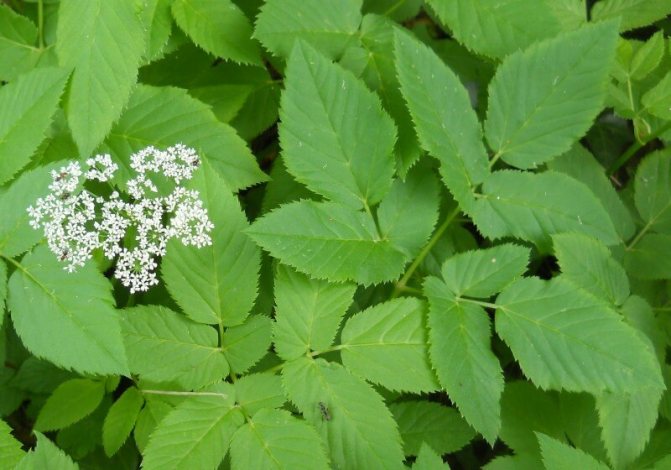

At the top of the stem is the largest umbrella (the side umbrellas are smaller), with 20-30 rays. Umbrella-inflorescence consists of white, small-sized flowers with five almost heart-shaped petals. The fruits of the culture are oblong, reaching 3-4 mm in length. In very shaded places, for example, in forests, the plant can not bloom for several years, while multiplying only by rhizomes.
All sprouts of common dreaming have a common root and they can be considered as one plant, the minimum life span of which is approximately 50 years. All these interconnected shoots bloom at the same time, therefore, flowering with such a vast bush, the dream resembles a white cloud that has descended to our earth.
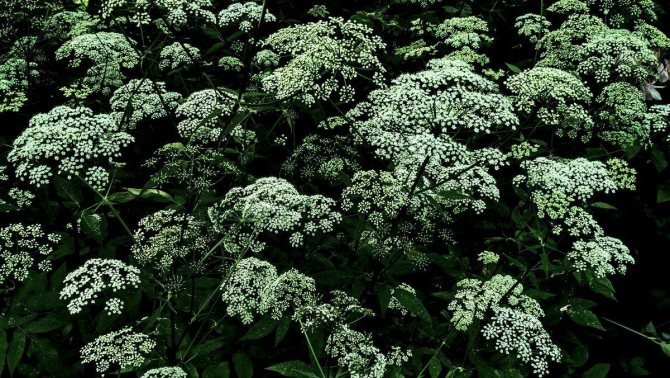

Good to know! Ivan Ivanovich Shishkin loved to draw very much. His two etudes depicting dreaming are currently in the Tretyakov Gallery and in the Russian Museum.It is interesting that the painting, which is kept in the Tretyakov Gallery, is called "Snack-Grass", as if reminding that snake is edible. Shishkin also often depicted moaning in the background or in the corners of his other paintings.
In addition to ordinary dullness, there is also decorative variegated dimness. It has elegant variegated leaves - snow-white spots flaunt on a green background. Just like the common runny, the decorative forms dense growths, reminiscent of a thick carpet, but only more colorful. Sometimes decorative runny can be found among the common runny bushes, it is from this plant that cultivated, ornamental varieties were once grown.
This herbaceous plant does not have a natural dormancy period, and its winter and autumn dormancy are forced. If the crop is grown in favorable conditions, it will be able to winter without shedding its green leaves. And in regions where winters are snowless, decorative variegated snow can grow for a whole year. The grass blooms in late June or July, begins to bear fruit in August.
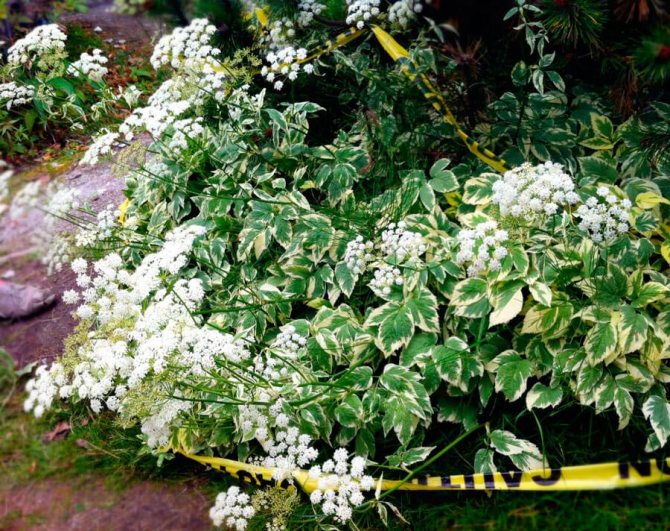

Interesting information! In ancient times, traders of vegetables and fruits always put dough with their goods, since it was believed that it was able to preserve the goods for a longer period. After a while, this superstition was explained by the fact that the grass contains natural pesticides that have antifungal and bactericidal properties. That is why she was able to protect fruits and vegetables from the development of fungal diseases, thereby increasing their shelf life.

